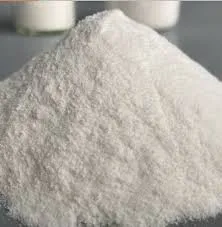
Agu . 16, 2024 20:41 Back to list
Solubility of HPMC in Various Organic Solvents for Enhanced Applications
Solubility of HPMC in Organic Solvents
Hydroxypropyl Methylcellulose (HPMC) is a well-known semi-synthetic polymer derived from cellulose that has found extensive applications in various industries, including pharmaceuticals, food, and cosmetics. Due to its diverse properties, such as film-forming ability, thickening, and emulsifying characteristics, HPMC is particularly valued in formulations. Its solubility in different organic solvents plays a crucial role in determining its functionality in various applications. This article aims to explore the factors influencing HPMC solubility in organic solvents and its implications across different sectors.
Understanding HPMC
HPMC is a cellulose ether that is modified to enhance certain properties. It is soluble in water and forms a viscous solution, making it an excellent thickening agent. However, depending on its degree of substitution and molecular weight, HPMC also exhibits varying solubility in organic solvents. The structural characteristics of HPMC contribute significantly to how it interacts with solvents, influencing its dissolution and functional properties.
Solubility in Organic Solvents
The solubility of HPMC in organic solvents depends on several factors, including the nature of the solvent, the degree of substitution of the polymer, and temperature. HPMC is generally poorly soluble in most organic solvents due to its hydrophilic nature. However, certain organic solvents can enhance its solubility
1. Ethanol and Ethanol-Water Mixtures Ethanol is one of the organic solvents that can dissolve HPMC effectively, especially in combination with water. The presence of water in the solvent mixture aids in breaking down the hydrogen bonds in HPMC, facilitating its dissolution.
2. DMSO and DMF Dimethyl sulfoxide (DMSO) and dimethylformamide (DMF) are polar aprotic solvents that can solvate the HPMC effectively. These solvents disrupt the intramolecular and intermolecular interactions within the polymer, promoting its solubility.
3. Chloroform and Acetone Although less common, certain studies have shown that HPMC can exhibit limited solubility in solvents like chloroform and acetone under specific conditions, particularly when mixed with co-solvents that can enhance its solubility.
hpmc solubility in organic solvents

Factors Influencing Solubility
- Degree of Substitution The solubility of HPMC varies with its degree of substitution. Higher substitution levels usually result in increased hydrophobicity, affecting its solubility in organic solvents. - Temperature Increased temperature often improves the solubility of HPMC in organic solvents. Higher temperatures provide the necessary energy to overcome the cohesive forces in the polymer chains.
- Molecular Weight The molecular weight of HPMC also plays a significant role. Higher molecular weight HPMC tends to have lower solubility due to greater entanglement and intermolecular cohesion.
Applications in Industry
Understanding the solubility of HPMC in organic solvents is critical for many applications. In the pharmaceutical industry, for instance, HPMC is used in drug formulation for its binding and controlled-release properties. The ability to formulate HPMC-based systems in organic solvents can enhance the bioavailability of certain drugs.
In the food industry, HPMC is utilized for its thickening and stabilizing properties. Its solubility in various solvents can aid in developing novel food formulations with improved texture and shelf-life.
Conclusion
In summary, the solubility of HPMC in organic solvents is determined by its molecular structure, the properties of solvents, and environmental conditions such as temperature. As HPMC continues to find applications across multiple domains, understanding its solubility behavior will remain crucial for optimizing its use in formulations and enhancing product performance. Researchers and manufacturers need to keep exploring solvent systems that can better solubilize HPMC to meet the evolving demands of various industries.
-
The Widespread Application of Redispersible Powder in Construction and Building Materials
NewsMay.16,2025
-
The Widespread Application of Hpmc in the Detergent Industry
NewsMay.16,2025
-
The Main Applications of Hydroxyethyl Cellulose in Paints and Coatings
NewsMay.16,2025
-
Mortar Bonding Agent: the Key to Enhancing the Adhesion Between New and Old Mortar Layers and Between Mortar and Different Substrates
NewsMay.16,2025
-
HPMC: Application as a thickener and excipient
NewsMay.16,2025
-
Hec Cellulose Cellulose: Multi functional dispersants and high-efficiency thickeners
NewsMay.16,2025







